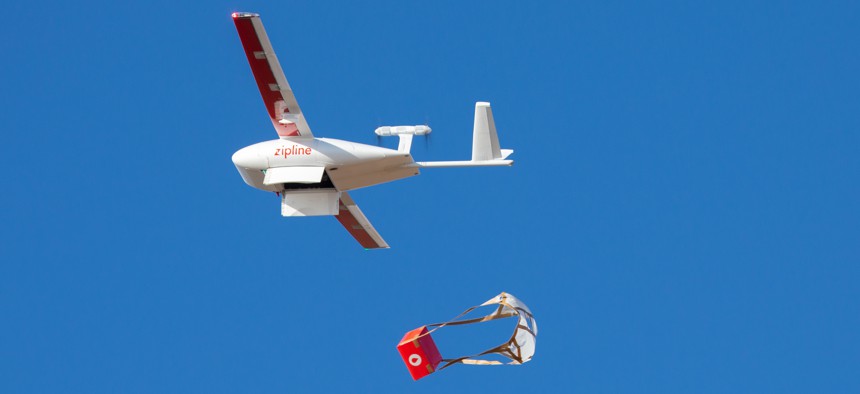
A medical delivery drone from Zipline Zipline
US Marines Try Using Drones to Bring Blood to Battle
The light unmanned aircraft made hundreds of supply drops during recent Australian live-fire wargames.
In August, over the dusty fields of Australia, highly autonomous drones made more than 380 deliveries of blood and other medical supplies to troops amid a live-fire exercise with U.S., Australian, and other forces.
The drones were from a small startup called Zipline, hired by the Defense Innovation Unit and the Naval Medical Research Center's Naval Advanced Medical Development to show how next-generation delivery drones could bring medical and other supplies to the front lines. Over a set of four exercises — Bundey I, Koolendong-19, Bundey II, and Crocodile Response — the Zipline drones flew under live rounds to drop small parachute bundles at their destinations. All told, they flew 461 day and night sorties and made 381 drops. It was the first time a U.S. Marine Air-Ground Task Force had incorporated autonomous drone delivery into their high availability, disaster recovery planning.
The Marines have used drones for cargo delivery before. Between 2011 and 2015, two unmanned K-MAX helicopters flew nearly 1,000 cargo missions in Afghanistan. The Marines are still using the K-MAXes, which are currently being fitted with more autonomous capabilities, but the Zipline drones offer a new realm of delivery options.
Next to a 3-ton K-MAX helicopter, which can carry its own weight in payload, the fixed-wing Zipline drones are tiny, with a wingspan of around seven feet and a payload of just 4.5 pounds. Rechargeable batteries fly them up to 100 km per hour, about two-thirds the cruise speed of a K-MAX. But they are far easier to load and operate, which allows them to make a lot more drops than the K-MAX. A Zipline distribution center, essentially a drone hub, can cover more than 8,000 square miles, the company said in a statement. They also don’t need to loiter in place to make a delivery. Instead, they fly over the site, open a small center bay, and drop a parcel that parachutes to a landing.
Related: Russian Troops Will Be Getting Tactical Bomb Drones
Related: US Testing Autonomous Border-Patrol Drones
Related: US to Deploy Anti-Drone Defenses Along US-Mexico Border
The company has been doing medical supply drops over Rwanda since 2016. In April, they set up their first distribution center in Ghana; in September, they announced a separate deal with the Indian government.
A year ago, the U.S. military asked Zipline to demonstrate how quickly they could set up to fly supply missions. The company responded by quickly dispatching eight drones on 227 sorties in rain, darkness, fog and other conditions over an undisclosed location over the United States. One 79-mile round trip set a U.S. record for the longest commercial drone flight.
“It fills a gap in a capability we don’t have, and that’s to rapidly resupply life-saving medical supplies,” said Lt. Shane Kim, of the Marine Corps’ Combat Logistics Battalion One, in a statement.
With further research and development of range, payload, and hardening up the logistics hub for expeditionary missions, “it could absolutely be implemented further down the road,” Kim said.
